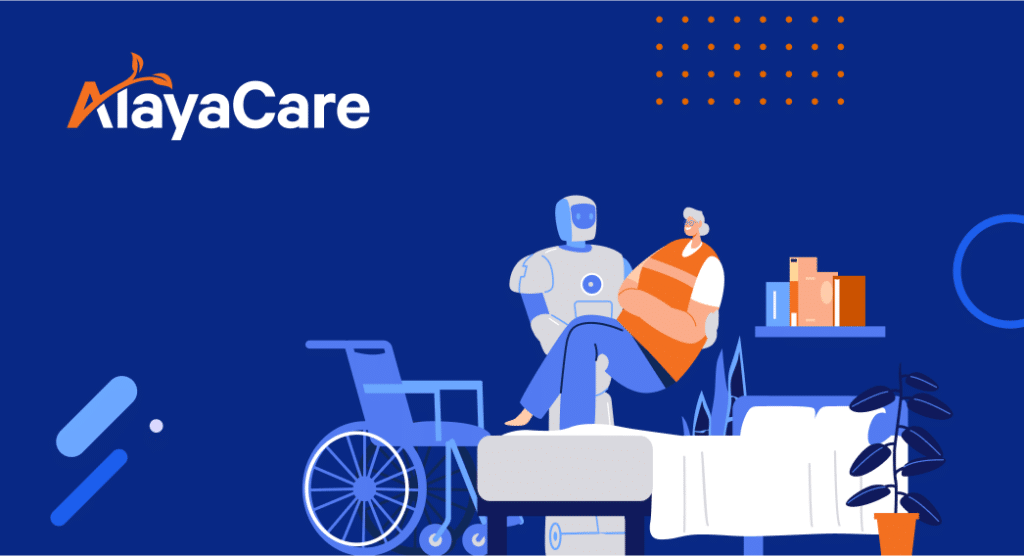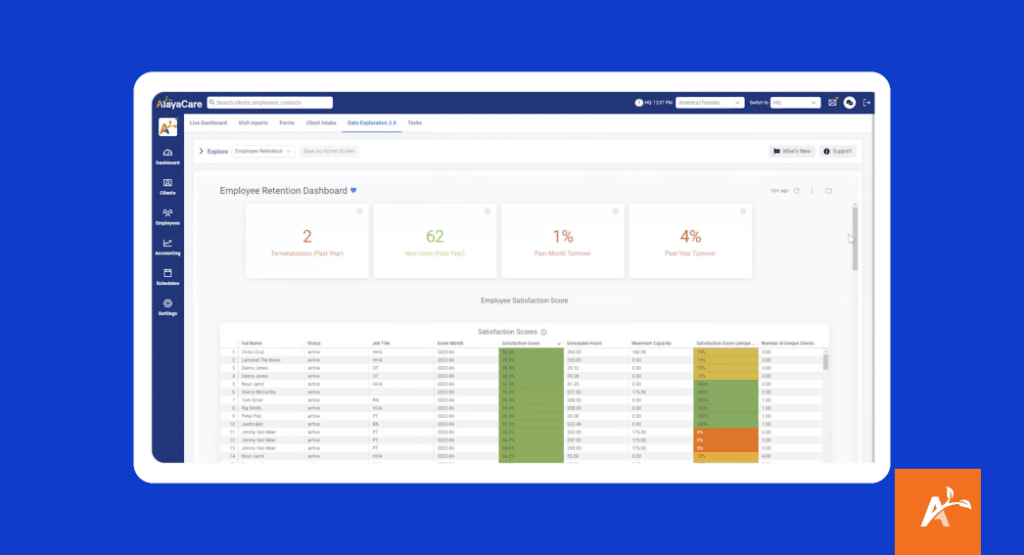Blog
5 emerging AI trends in home care in 2024

If we were going to nominate a 2024 word of the year, it would be Artificial Intelligence (AI).
Everywhere you turn, people are talking about the power of ChatGPT, the use of machine learning, or new and emerging large language models (or LLMs). But only recently has this conversation moved into the home care space.
This space has enormous potential. Between 2021 to 2022, over 818,000 people received commonwealth home support in Australia according to GEN Aged Care Data. And the home healthcare market is expected to grow by 9.45% from 2023 to 2030.
The available home care technology is evolving quickly. We wanted to take stock of how AI is already being used in home care, and what we can expect in the future.
We talked to our resident AI and LLM experts, Senior Vice President of Data & Intelligence, Naomi Goldapple, and Data & Intelligence Product Manager, Sarah Khalid, to learn what trends are set to impact the sector this year, and critically, how you can implement them to improve efficiency.
5 AI trends in home care
1. LLMs (like ChatGPT) will be used a lot more this year
Firstly, to address the virtual elephant in the room: what is an LLM?
“An LLM is an advanced AI powered system that understands and generates human-like text by learning from massive amounts of data.”
Where did we get that definition from?
ChatGPT of course, the best known LLM.
LLMs allow you to ask questions, request definitions, seek advice, summarise documents, and other writing-related tasks. And increasingly, it doesn’t just help with writing.
With only a few prompts, LLMs can create whole images and videos.

So, how will LLMs actually be used for home care services?
According to Naomi, they’ll mostly be used “just like everybody else is using them.”
Specifically, this will include asking them questions, summarising information like emails, and helping write documentation.
Sarah explains that this is where LLMs really thrive.
“You wouldn’t expect LLMs to reason as well as they do. When you provide it with the right context, the answers you receive back are fascinating.”
Naomi added that this is particularly valuable in home care settings, explaining that “in home care, there’s a lot of contextual information. You need to understand where clients have come from, what their history is, what’s happened in the previous visits.
“The ability for LLMs to gather all that data and generate it into very digestible, consumable, bite-size chunks while you’re doing your work is a huge efficiency gain. The more that we can provide that information to the frontend workers who are really dealing with the clients, the better.”
2. AI will make care feel more personal
OK, we know, using a machine to help deliver personalised care sounds contradictory. But stay with us.
The way we typically get patient information is, well, clunky. That’s not the fault of the worker, but the systems we’re using.
To get a snapshot of a client, there’s a huge amount of data we must sort through. Administrative information, care plans, doctor’s discharge notes, the list is never-ending. And if that client has been in the system for a while, it’s even harder.
LLMs can summarise this data much better than us.
Do you want to know when a client has had a fall in the last year? The name of the client’s partner? Or their cat’s favourite toy?
With the right fine-tuning, LLMs can deliver this information instantly.
This functionality allows you to provide an even more personalised service because you won’t be bogged down in (and potentially missing) the detail.
“I’m most excited about LLMs being able to summarise and generate suggestions based on what’s most important for folks within the aged care industry,” says Sarah.
“It can tell us things like, ‘what kind of actions should I do based on this information?’ ‘What has changed from the previous visit that I should pay attention to next visit?’
“This kind of information helps arm workers with the right knowledge so they can do their job more easily.”
As technology like this is increasingly adopted in home care, we’ll see care become more personalised for the end user.
3. AI will help prevent home care worker attrition
If you ask any leader within the home and disability sector, “what is the biggest issue in home care Australia?” the resounding answer will be: not enough staff.
We know it can be difficult to attract the right talent. But it can be even harder to keep them. And often, we have no idea why some care workers quit.
The result is a huge gap in the home care workforce.
A 2022 report by the Committee for Economic Development of Australia speculates the aged care sector will have a shortage of between 30,000 – 35,000 direct care workers annually. This is due to roughly 65,000 workers leaving their jobs each year.
So how would AI help solve this?
By predicting the future. Yes, really.

If you give AI models enough of the right data, they’ll tell you what might happen over time. This could be anything from, ‘when will this pipe be so worn down that it will burst?’ to, ‘what are the chances of rainfall in Oodnadatta tomorrow?’
And even, ‘which home care workers are feeling so unsatisfied that they are likely to quit?’
AlayaCare’s employee retention and churn predictor does exactly this.
“This is an AI model that uses various inputs such as schedules, amount of travel time and continuity of care with each client,” says Naomi. “It uses this data to predict who is at risk of quitting over the next 4 weeks by reviewing their perceived satisfaction in their role.”
The impact of this is significant. Armed with this knowledge, we can approach home care workers before they quit and help address some of the reasons they may be feeling dissatisfied (but more on that in the next section).
This is one of the ways AI can help tackle attrition, but as the technology evolves, so will its uses in tackling the other big issues in home care.
4. AI will TAKE OVER (our menial tasks)
No, this is not the plot of a science fiction movie. AI and LLMs really will take over, but not in the ways you’ve seen on the big screen.
“Folks are often worried that AI is going to replace what they’re doing in their day-to-day tasks. And to be honest, it will,” says Sarah. “AI is definitely going to transform the way that we work, the way that we live, the way that we exist. But, it’s not going to replace humans.
“Instead, it’s going to reduce the time we spend on menial tasks and leave space for us to do more of what we love.”
Naomi agrees. “Generative AI and LLMs’ ability to save time for the clinicians and the back-office staff is amazing. It improves communication between them and front-line staff, while also helping to complete menial tasks. It’s a huge time saver for the industry.”
One of the menial tasks it can help with is scheduling.
Not only can scheduling be hugely time-consuming, but it’s also prone to human error and oversights. Like putting a care worker on a shift three hours away from their home when there’s another worker free within a 10-minute drive. Or matching six different workers to a client over a week, when one worker can do all the shifts.
New technology like Visit Optimiser now automatically assigns care workers to the best shift based on location, continuity of care, and other factors.

Products like this start to address the root causes of care worker attrition.
This is just the beginning of the many ways we’ll see AI and LLMs support us with tasks we’d rather not do in the future.
5. AI will start to feel like a personal assistant
AI is evolving to be a handy personal assistant that you can carry in your pocket. Need to book a flight? It has you sorted. Want to change that doctor’s appointment? Done and done.
In home care, it will be exactly the same.
AI will become a concierge for a client and their family, or a liaison between caregivers and care seekers. It will even retrieve standard operating procedures: all you’ll need to do is whip out your phone, speak with your assistant, and continue on with your day.
Bonus: How is AI already impacting Australian home care?
While recently visiting from her Canadian homeland, Naomi remarked on the big uptake of AI and LLMs in Australia already.
“In the few weeks that I’ve been in Australia, most people I talked to admitted to using things like ChatGPT in their daily lives,” she says. “There seems to be a lot of knowledge about it which is great. People are using it to complete mundane tasks in their daily lives, and to plan their trips, there’s a lot of that.
“But in terms of using AI and LLMs in the home care industry, it really is still the wild west. It’s in its infancy. Australia is at the same stage as everybody else in the world, but the appetite to learn and start adopting it is huge.”
The start of something big
If you chat to anyone in the know, they’ll tell you just how big a ‘thing’ AI and LLMs are.
For our resident data and intelligence experts Naomi and Sarah, they feel exactly the same.
“I remember the advent of the internet. That was massive! Absolutely massive,” says Naomi. “It was completely transformational and it’s impossible to explain to your children what it was like not to have the world’s information at your fingertips.
“The conversational ability of this new technology is what makes it just as transformational as the internet.”
Sarah agrees, “the advent of AI and the LLMs that we’re using today, it’s definitely a new technological breakthrough.
“AI and LLMs are going to change the way we think about every technology we use. They’re here to stay, and they’re here to evolve.”
We spoke to Naomi and Sarah while they attended AlayaLab’s recent roadshow, Transformative technology: Navigating the landscape of AI, data and large language models. Read more about the topics discussed around worker attrition and visit optimisation.
Want to learn more about AlayaCare’s work in transformative technology? Head to our AlayaLabs page.


